Overview
Automated land document indexing presents significant advantages for title research, notably increased efficiency, enhanced accuracy, substantial cost savings, and improved collaboration among teams. The evidence is compelling:
- Time savings exceed 90% in document processing.
- Accuracy rates reach as high as 99.9%.
- Cost reductions can be as much as 35%.
These figures demonstrate how automation not only transforms traditional workflows but also enhances overall productivity within the real estate sector.
Introduction
The real estate industry is experiencing a transformative shift as automation becomes increasingly integral to its operations. Automated land document indexing, powered by advanced technologies such as machine learning and optical character recognition, promises to revolutionize title research by dramatically enhancing efficiency and accuracy.
Furthermore, as organizations strive to adopt these innovative solutions, they must navigate the complexities of implementation and integration.
What are the key benefits of embracing automated indexing?
How can firms ensure they leverage these advancements to stay competitive in a rapidly evolving market?
The answers to these questions will not only illuminate the path forward but also reinforce the necessity of adapting to these technological advancements.
Parse AI: Streamline Land Document Indexing with Advanced Automation
The AI system employs advanced machine learning and optical character recognition technologies, which facilitate automated land document indexing and revolutionize the indexing of land records. By swiftly extracting vital information from extensive groups of records, Parse AI markedly reduces the time and effort typically associated with automated land document indexing. This system not only streamlines workflows but also significantly boosts the efficiency of title research processes by utilizing automated land document indexing.
Real estate experts have reported substantial improvements, with some organizations achieving processing time reductions exceeding 90%. For instance, a logistics firm successfully decreased its file processing duration from over 7 minutes to under 30 seconds.
As the industry increasingly embraces mechanization, the integration of advanced technologies such as automated land document indexing offered by Parse AI is becoming essential for maintaining a competitive edge in the rapidly evolving real estate market. Furthermore, a recent study indicates that companies implementing Intelligent Document Processing (IDP) solutions can realize a return on investment (ROI) ranging from 30% to 200% within the first year, underscoring the financial advantages of adopting such technologies.
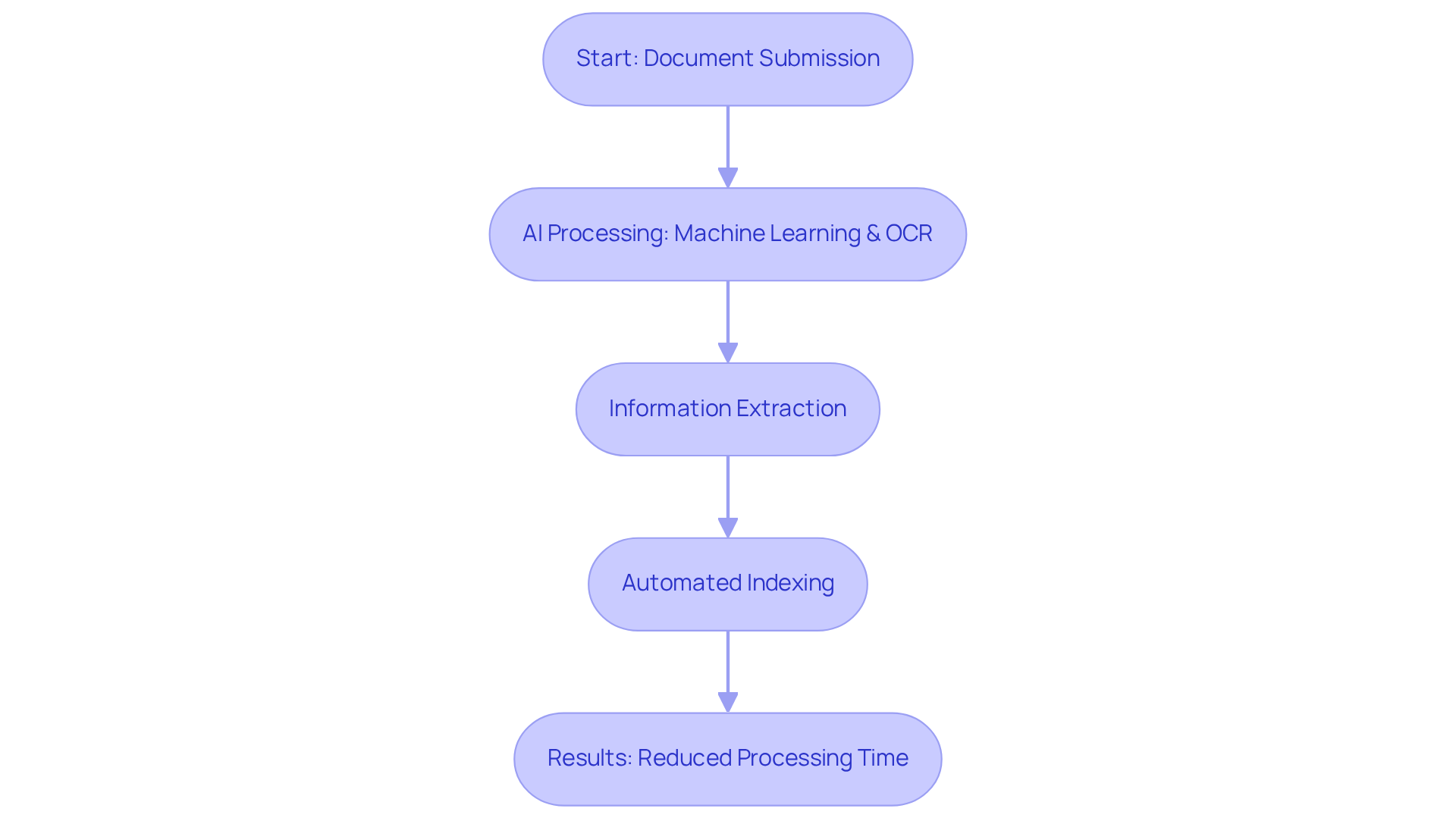
Increased Efficiency: Reduce Time Spent on Manual Document Processing
Automated land document indexing significantly enhances the manual processing workflow, enabling researchers to accomplish tasks in a fraction of the time required by conventional methods. For instance, while manual data entry can take 5-10 minutes per transaction, automated systems like SenseTask reduce this to mere seconds, translating to substantial time savings.
Title researchers indicate that automated land document indexing can yield up to 82% time savings when producing legal papers, enabling them to manage more cases simultaneously. This increased efficiency, driven by automated land document indexing, not only enhances productivity but also accelerates turnaround times for clients, fostering improved service delivery.
A notable example features a national company that decreased document clearance duration from 2-4 hours to merely 20 minutes through mechanization, aligning with the broader trend of Intelligent Document Processing (IDP) solutions enhancing turnaround times. Furthermore, automated land document indexing with SenseTask reduces the error rate to nearly zero, underscoring the reliability of automation in document processing.
Overall, these advancements empower professionals in the field to focus on more strategic tasks rather than manual data entry, thereby improving operational efficiency and client satisfaction.
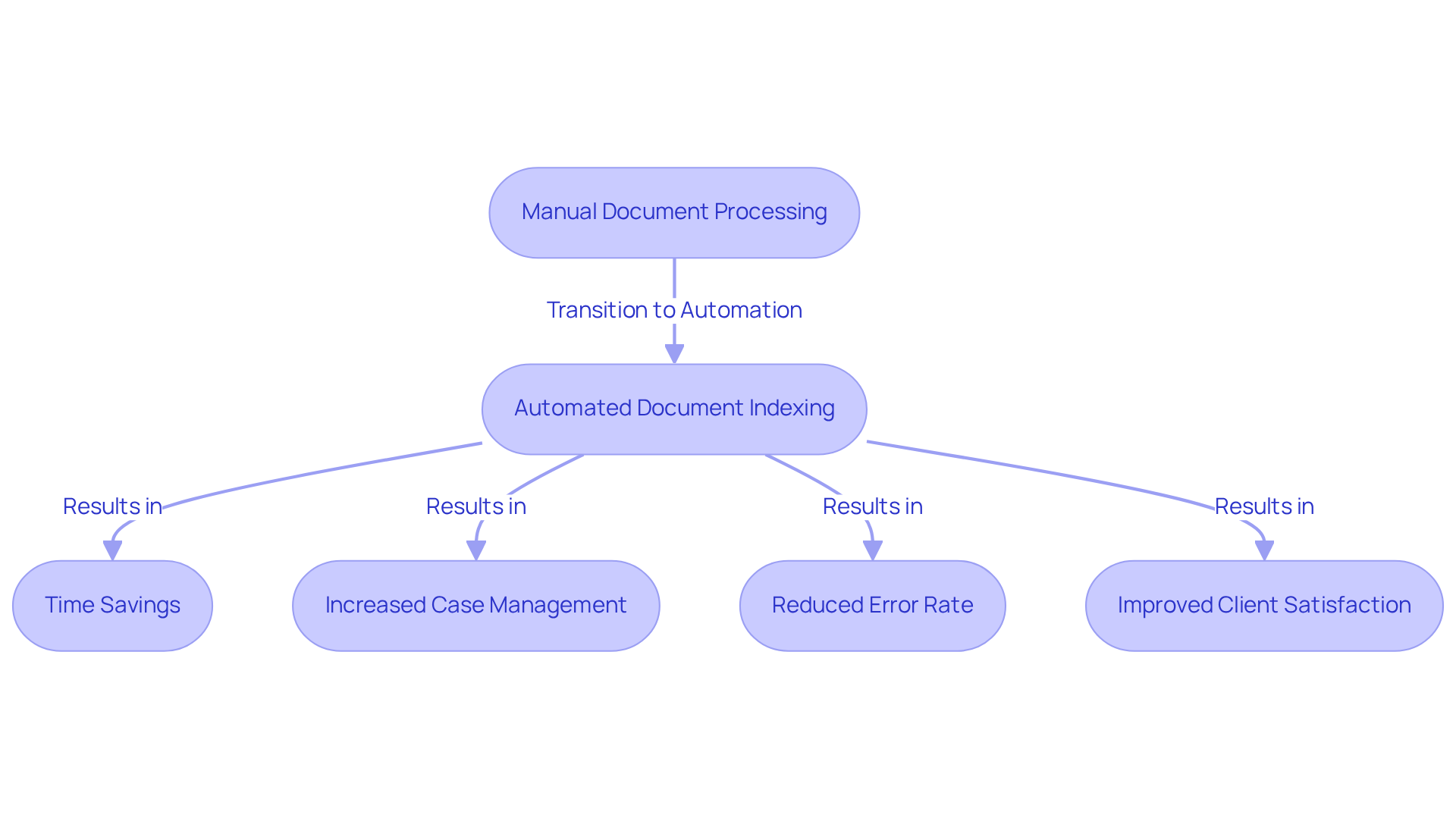
Enhanced Accuracy: Minimize Errors in Title Research and Document Management
Automated land document indexing is pivotal in enhancing the precision of research by significantly reducing human errors typically associated with manual data entry. By leveraging advanced algorithms, including Optical Character Recognition (OCR), Parse AI guarantees that the automated land document indexing yields information extracted from land records that is both accurate and reliable. This technological innovation not only diminishes inaccuracies but also facilitates automated land document indexing to produce more dependable property reports, which are vital for ensuring compliance and mitigating potential legal disputes.
Statistics indicate that automated data entry systems can achieve accuracy rates as high as 99.9%, with a low error rate of approximately 2%, in stark contrast to the average error rate of 20% found in manual processing. Furthermore, organizations that have embraced automated land document indexing have reported a reduction in claim denials by up to 30%, supported by evidence that this automated land document indexing can decrease errors in claims processing by as much as 90%.
Industry leaders assert that integrating automated land document indexing not only enhances operational efficiency but also fosters a more secure and traceable workflow, effectively addressing the shortcomings of traditional manual entry methods. As Chris Zaugg observes, 'Automated applications are quicker than manual input,' highlighting the transformative potential of automation in record management.
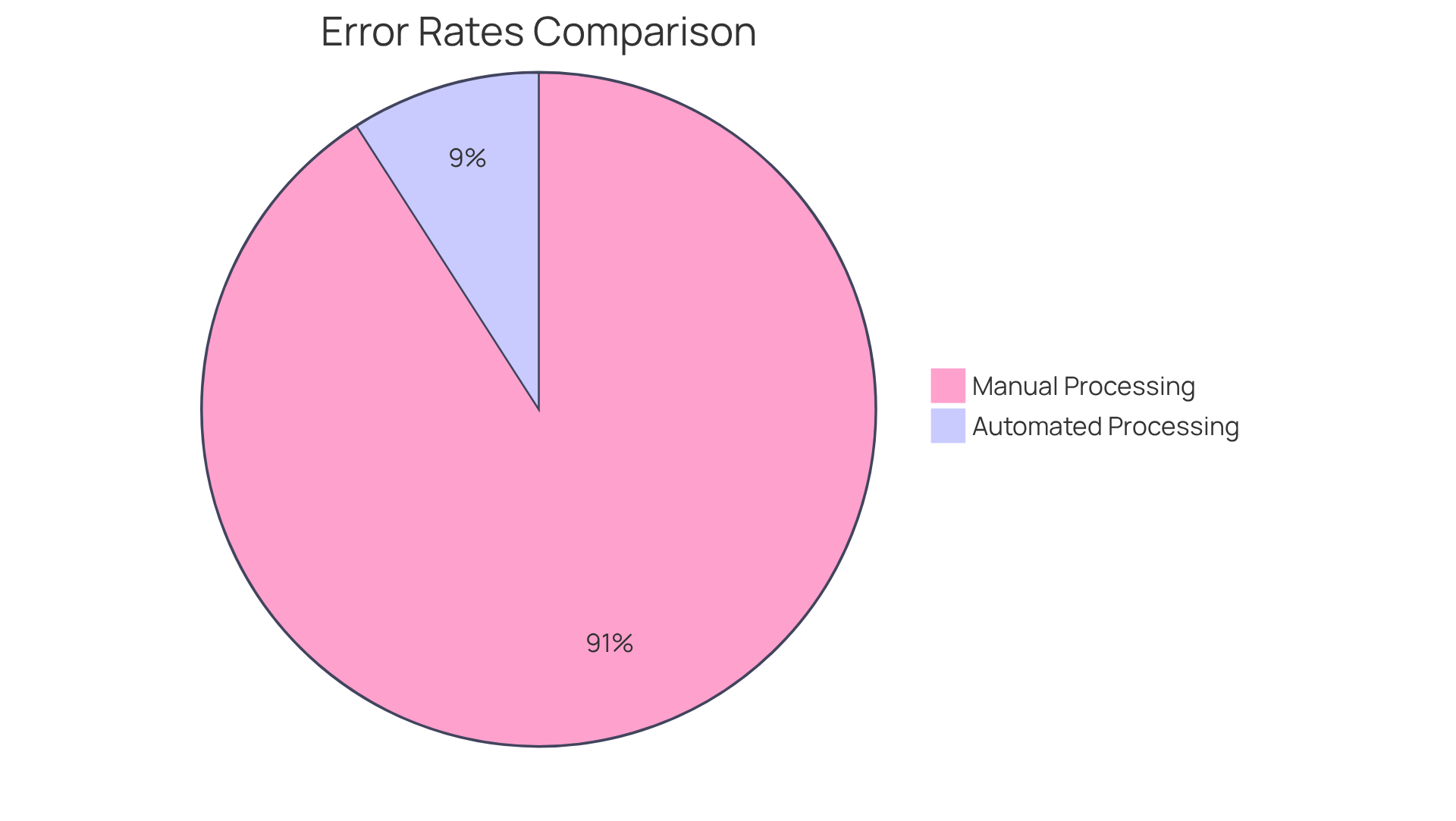
Cost Savings: Lower Operational Costs Through Automation
Implementing automated land document indexing yields substantial cost savings for research firms. This approach to automated land document indexing significantly reduces reliance on manual labor, enabling organizations to lower operational costs while minimizing errors that may lead to expensive legal complications.
Companies employing Intelligent Document Processing (IDP) can reduce the cost of manual paperwork handling by 35%, resulting in millions in savings each year. Furthermore, IDP can decrease processing times by 50-70%, enabling firms to manage a greater volume of clients without incurring additional overhead. This efficiency enhances profitability and positions firms to remain competitive in a rapidly evolving market.
Consequently, the financial impact of errors in manual title research, which can cost firms thousands in rectification and legal fees, is mitigated through the precision and speed offered by automated land document indexing systems.
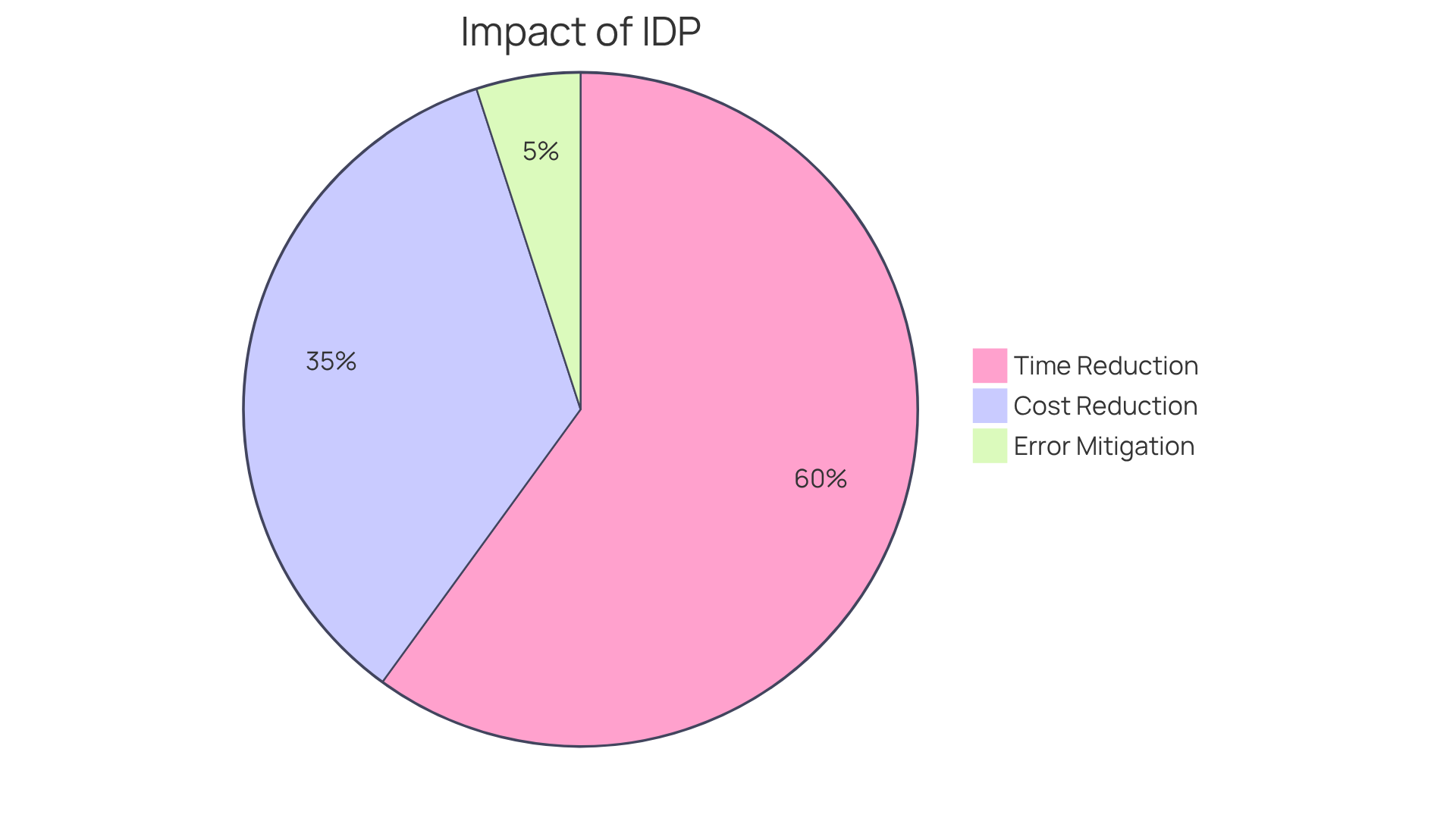
Scalability: Efficiently Manage Large Volumes of Land Documents
Automated land document indexing solutions, such as those provided by Parse AI, are meticulously crafted to efficiently manage extensive land records. In light of the surge in real estate transactions, the ability to scale operations without compromising quality has become essential. Automation empowers firms to efficiently process and index vast datasets, such as through automated land document indexing, enabling them to satisfy growing client demands without necessitating a proportional increase in staffing.
For example, organizations that have adopted Intelligent Document Processing (IDP) report processing speeds that can reach up to 100 times faster than traditional methods, markedly improving operational efficiency. As Andrew Carnegie aptly noted, "Ninety percent of all millionaires achieve this through owning real estate," underscoring the importance of effective record management in this sector.
Furthermore, with an estimated 80-90% of enterprise data being unstructured, leveraging AI-driven solutions not only streamlines workflows but also unveils the potential of previously untapped information. This strategic approach to document management enhances accuracy and positions firms to excel in a competitive landscape.
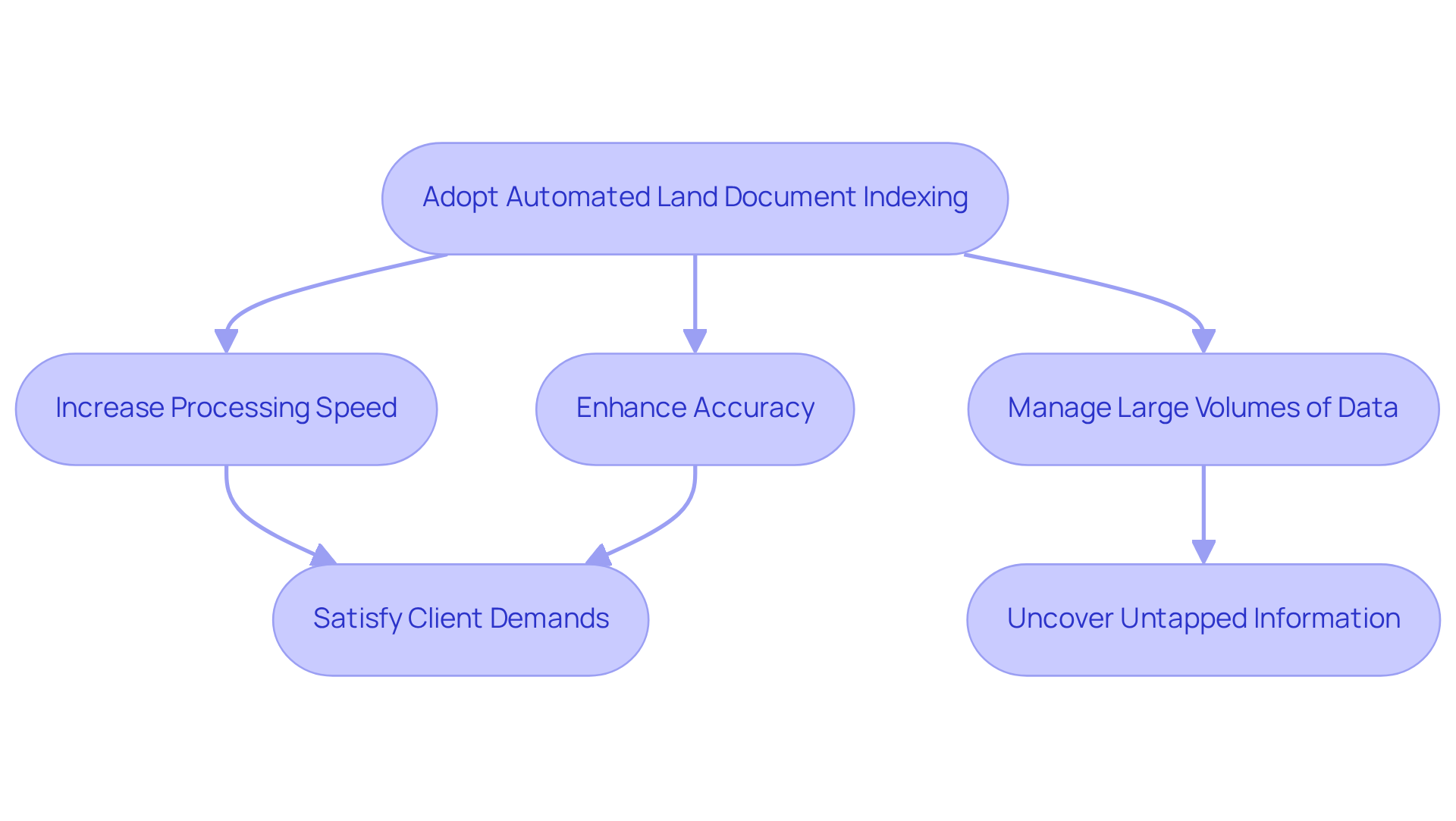
Integration: Seamlessly Connect with Existing Title Research Tools
Parse AI's solution for automated land document indexing is meticulously designed to integrate seamlessly with current research tools. This compatibility empowers organizations to enhance their workflows without the burden of extensive retraining or disruptive system overhauls. By connecting with established systems, firms can harness the advantages of automation, particularly through automated land document indexing, while preserving their current processes.
Consequently, this approach not only streamlines operations but also significantly increases productivity, enabling researchers to concentrate on higher-value tasks. As McKinsey notes, 'half of all work can be automated,' highlighting the significance of seamless technology adoption in title research workflows, especially with automated land document indexing.
Furthermore, studies show that 'workflow automation can enhance data precision by as much as 88%,' emphasizing the concrete advantages of incorporating AI's solution in automated land document indexing. Addressing potential challenges, it is crucial for organizations to consider the adaptability of their teams and the alignment of new technologies with existing workflows to ensure a smooth transition.
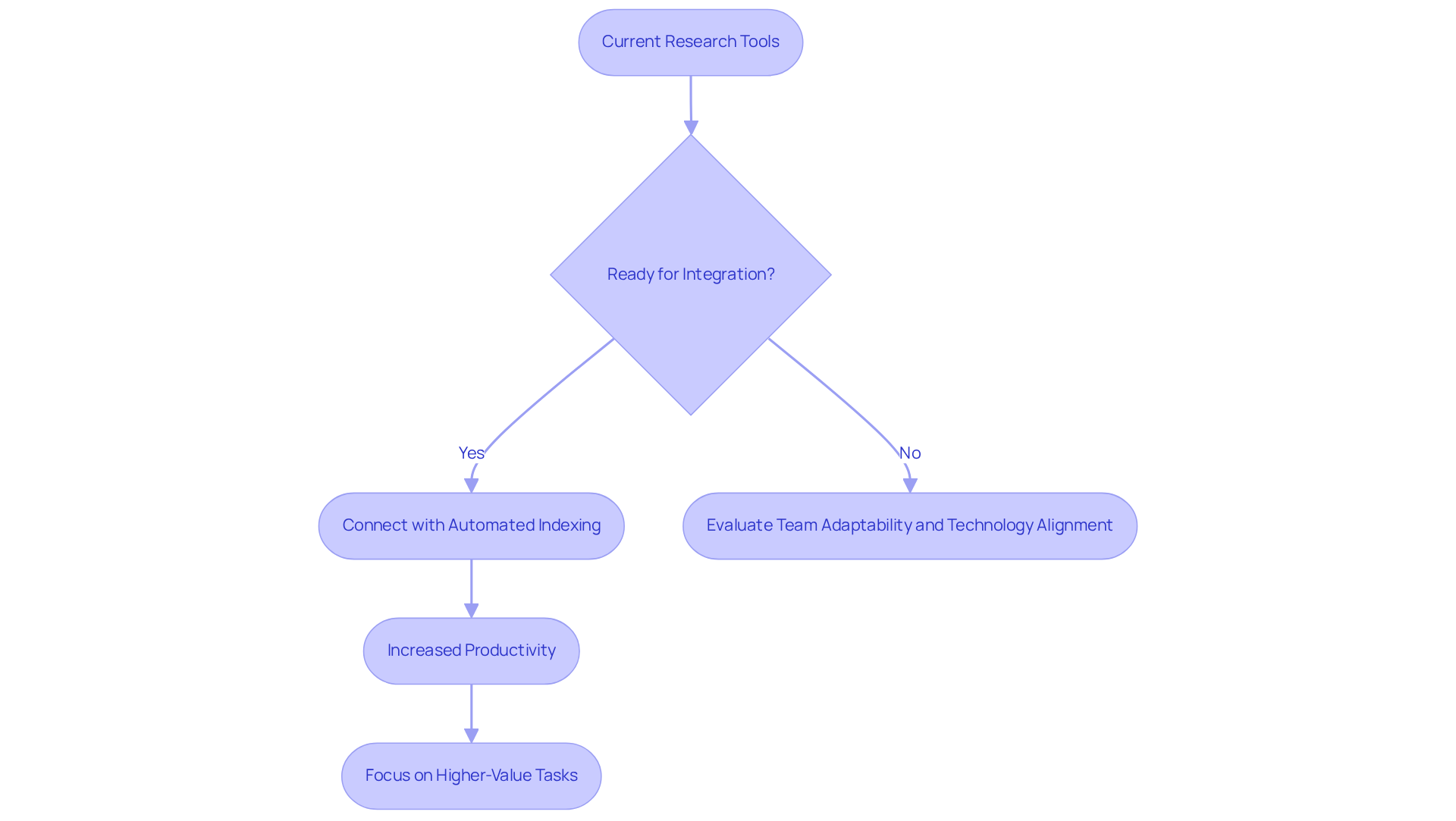
Regulatory Compliance: Ensure Adherence to Legal Standards with Automation
Ensuring adherence to regulatory compliance is pivotal through automated land document indexing, which maintains accurate and organized records. Parse AI's technology is meticulously designed to meet legal standards, significantly mitigating the risk of non-compliance associated with manual processes. By utilizing automated land document indexing, firms can effectively align their documentation practices with industry regulations, thereby safeguarding their operations.
For instance, organizations leveraging technology in compliance management report that:
- 64% experience improved risk visibility
- Quicker issue detection—both vital for upholding compliance.
Furthermore, legal experts assert that automated land document indexing not only streamlines processes but also enhances the capability to meet evolving regulatory requirements. This proactive approach to compliance is essential, particularly in a landscape where:
- 85% of businesses acknowledge that compliance has become increasingly intricate, underscoring the necessity for innovative solutions like AI to tackle these challenges effectively.
Additionally, breaches can cost nearly $220,000 more on average when non-compliance with regulations is a factor, highlighting the significant financial stakes involved.
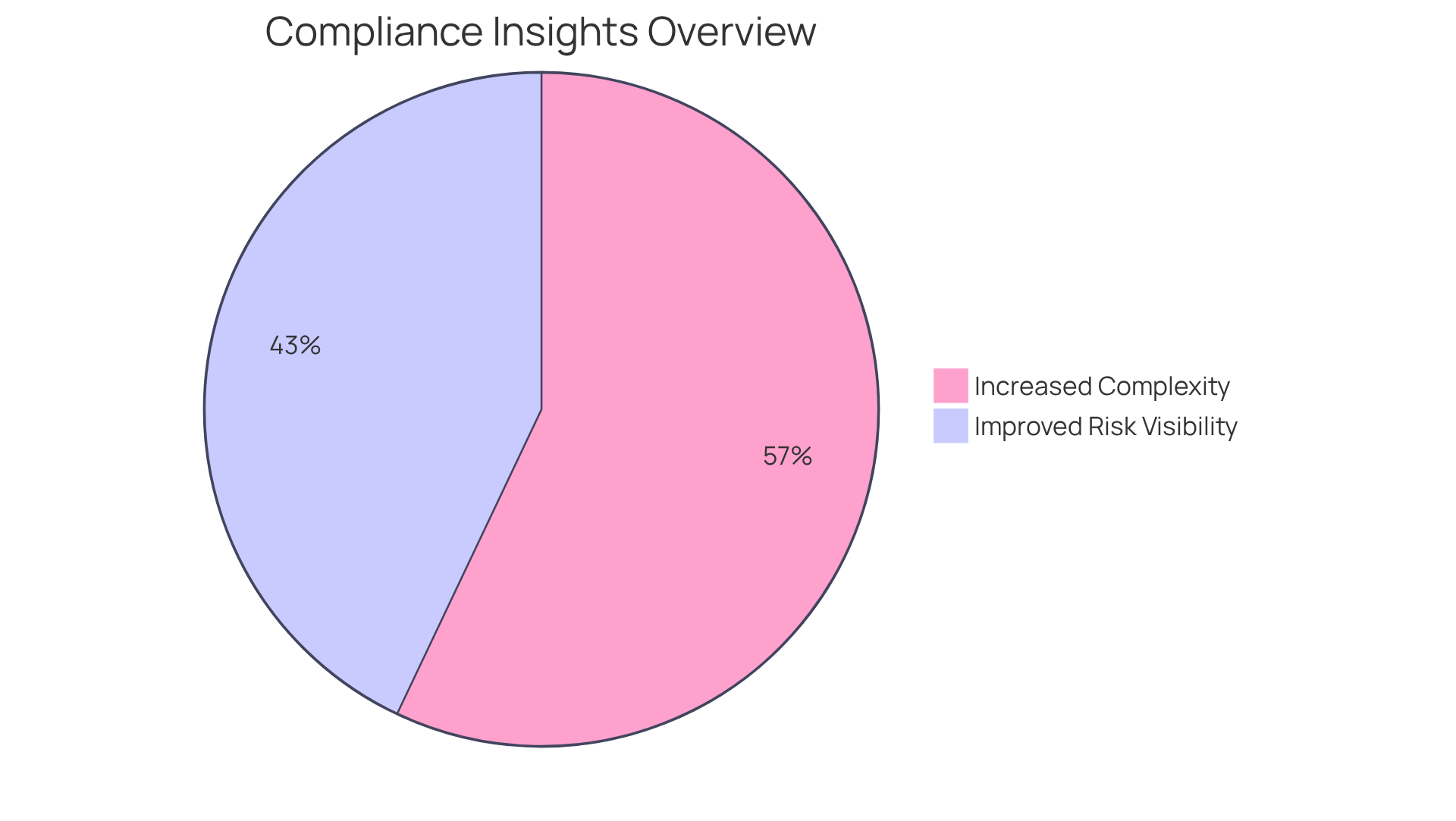
User-Friendly Interfaces: Simplify Adoption of Automated Indexing Solutions
Parse AI underscores the critical role of user-friendly interfaces in its automated land document indexing solutions, which are designed to streamline the adoption process for title researchers. Intuitive designs significantly diminish the learning curve, allowing staff to swiftly attain proficiency with the system.
Research reveals that employees receiving effective training on new technology can adopt it nearly three weeks faster than their counterparts who do not. Furthermore, the average employee requires approximately 5.6 weeks to embrace new technology, emphasizing the necessity of user-friendly interfaces in facilitating this transition. This ease of use not only fosters greater acceptance of automated land document indexing within organizations but also enhances overall workflow efficiency.
Consequently, title researchers can concentrate more on their core responsibilities, ultimately boosting productivity and accuracy in property ownership verification. Companies that adopt leading design practices experience growth rates twice that of the industry benchmark, further accentuating the value of user-centric design.
As Steve Jobs famously articulated, "Technology is nothing. What’s important is that you have a faith in people, that they’re basically good and smart, and if you give them tools, they’ll do wonderful things with them.
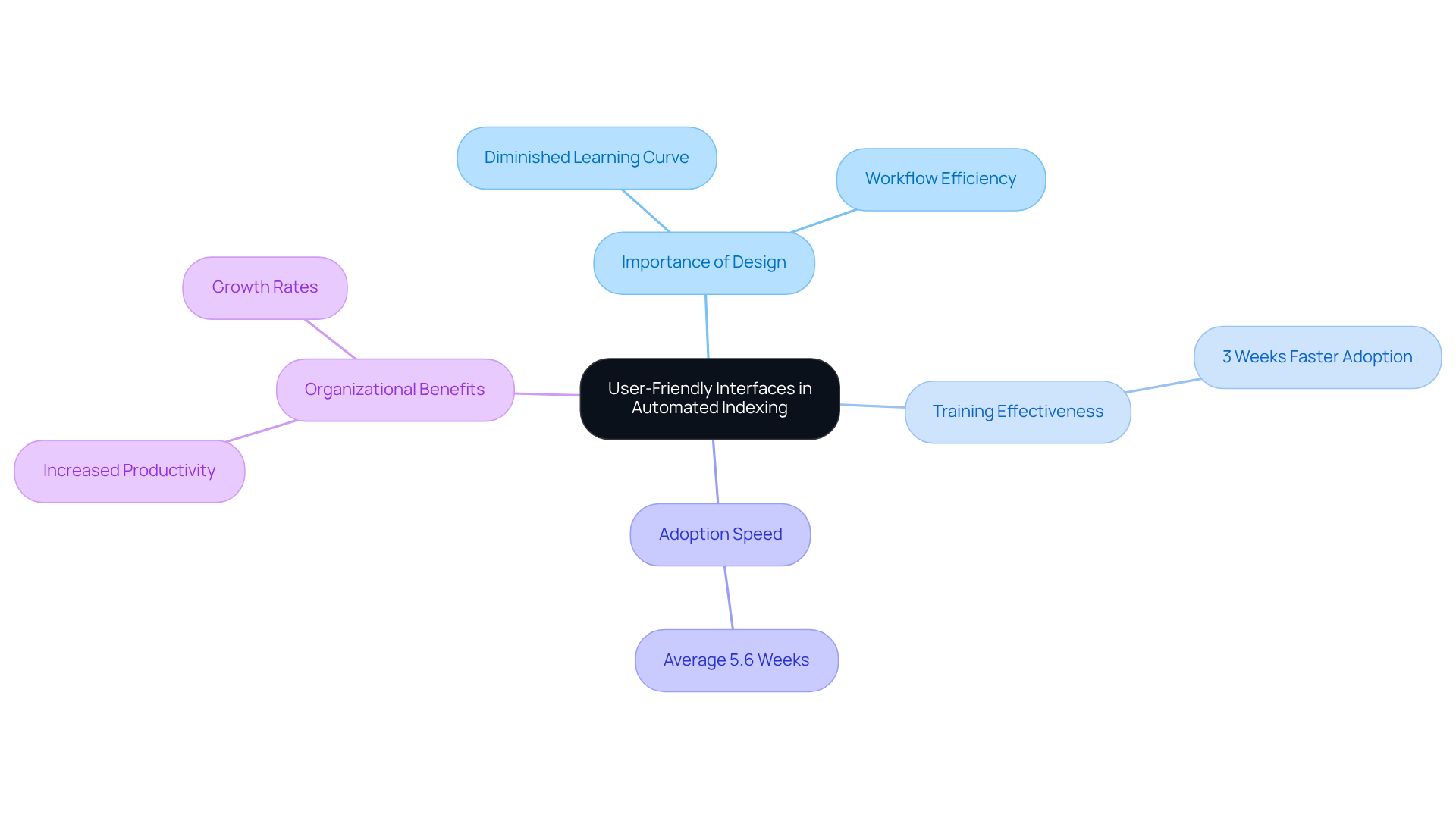
Continuous Improvement: Benefit from Ongoing Enhancements in Automation Technology
The landscape of automation technology is perpetually evolving, and this AI system stands at the forefront of this transformation. By consistently updating its indexing solutions, Parse AI harnesses the latest advancements in machine learning and optical character recognition, ensuring that users benefit from cutting-edge technology. This proactive strategy enhances the efficiency of automated land document indexing and empowers organizations to maintain competitiveness in a rapidly changing market.
Statistics indicate that automation can significantly reduce error rates in processing materials, with some reports revealing reductions of 40-75%. As the demand for efficient title research escalates, Parse AI's unwavering commitment to ongoing enhancements positions it as a leader in the industry, enabling real estate professionals to swiftly adapt to market fluctuations.
According to industry specialists, the incorporation of sophisticated machine learning methods is transforming how we manage land records, particularly through automated land document indexing, making processes quicker and more dependable.
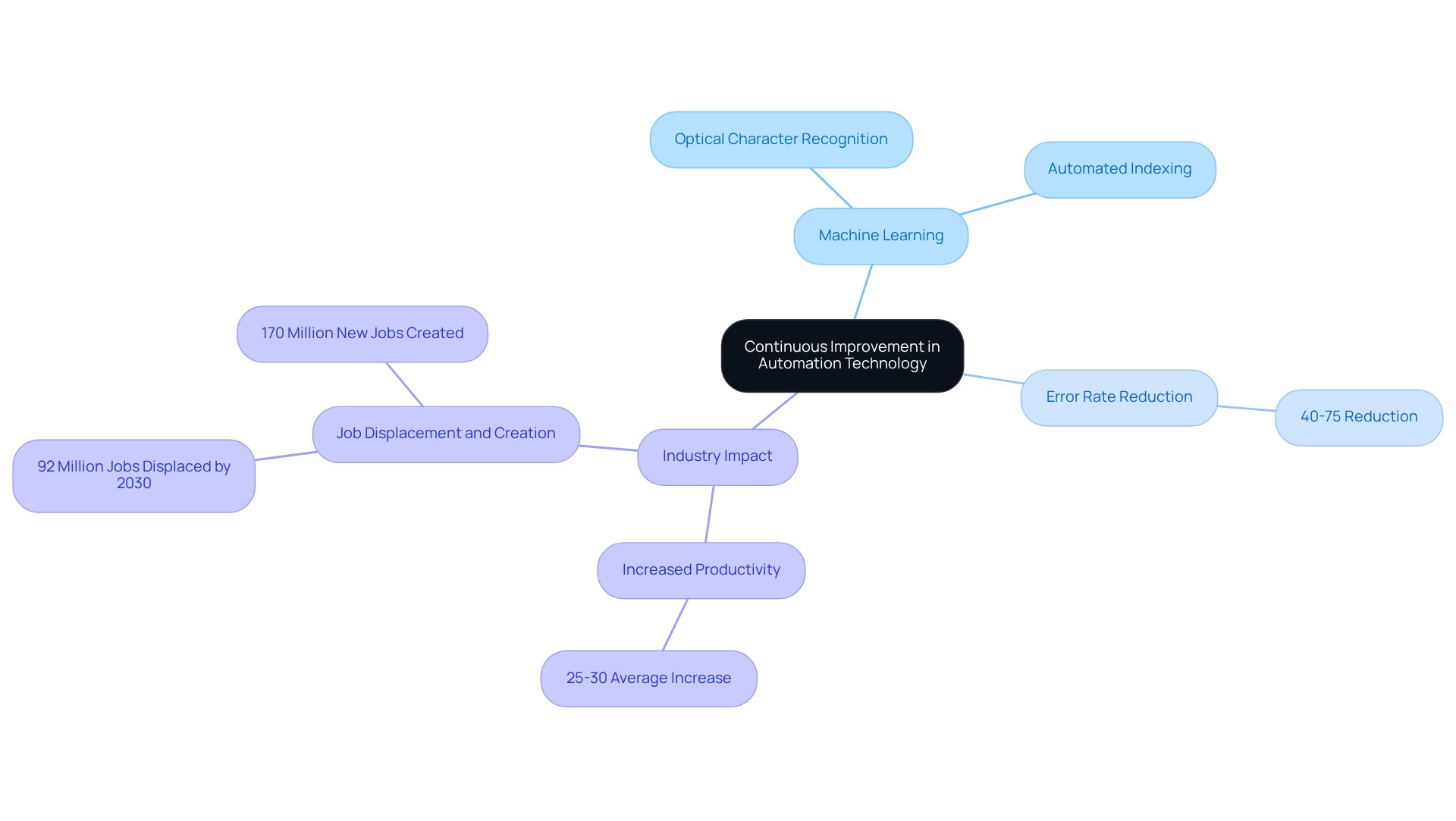
Collaboration: Foster Teamwork and Communication Through Automated Solutions
Automated land document indexing solutions significantly enhance collaboration among team members by offering a centralized platform for managing files. With Parse AI, teams can effortlessly share and access indexed files, streamlining communication and boosting workflow efficiency. This collaborative environment not only fosters teamwork but also enables professionals to work together more effectively on research projects.
Notably, 70% of employees believe that improved collaboration positively impacts productivity and conserves resources, highlighting the critical nature of real-time access to information. Furthermore, 44% of businesses report that the ability to share, edit, and access files remotely is the most crucial advantage of automated land document indexing, illustrating how automation simplifies complex tasks.
By leveraging these tools, Parse AI empowers title researchers to enhance their collaborative efforts, ultimately leading to superior outcomes in their projects.
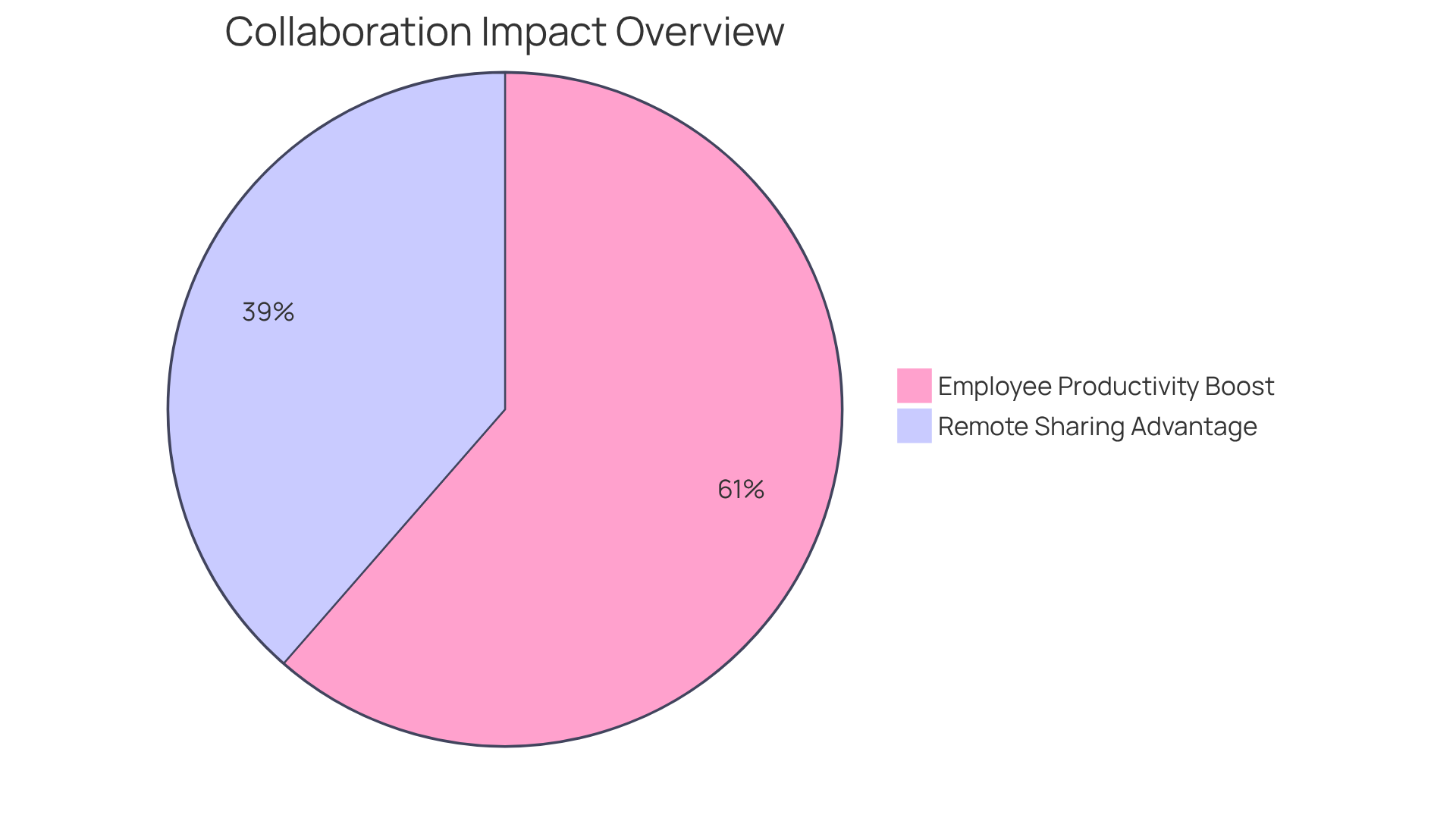
Conclusion
Automated land document indexing signifies a transformative leap in title research, fundamentally reshaping how professionals manage and process land records. By harnessing advanced technologies such as machine learning and optical character recognition, this innovative approach streamlines workflows while enhancing accuracy, efficiency, and cost-effectiveness in document handling. The shift towards automation is not merely a trend; it is an essential evolution for firms striving to maintain a competitive edge in the fast-paced real estate market.
The benefits of automated land document indexing are substantial. Organizations have reported remarkable improvements in processing times, with reductions exceeding 90% in some instances. This efficiency translates into significant cost savings and enhanced productivity, enabling title researchers to focus on strategic tasks rather than manual data entry. Furthermore, the accuracy of automated systems is far superior, with error rates plummeting to as low as 2%, thereby minimizing risks associated with compliance and legal disputes. Additionally, the ability to scale operations without sacrificing quality positions firms to effectively meet the demands of a growing market.
In a landscape where the complexities of regulatory compliance and the need for seamless integration with existing tools are ever-present, adopting automated land document indexing is crucial. As technology advances, embracing these automated solutions empowers organizations to enhance collaboration, improve operational efficiency, and ultimately deliver superior service to clients. The future of title research lies in automation, and the time to invest in these transformative tools is now.
Frequently Asked Questions
What is Parse AI and how does it improve land document indexing?
Parse AI is an advanced automation system that utilizes machine learning and optical character recognition technologies to streamline land document indexing. It automates the extraction of vital information from large groups of records, significantly reducing the time and effort involved in the indexing process.
What are the benefits of automated land document indexing?
Automated land document indexing enhances efficiency by reducing processing times, with some organizations reporting reductions exceeding 90%. It allows title researchers to manage more cases simultaneously and improves turnaround times for clients.
How much time can automated systems save compared to manual processing?
Automated systems can reduce manual data entry times from 5-10 minutes per transaction to mere seconds. For example, a national company reduced document clearance duration from 2-4 hours to just 20 minutes.
What impact does automated land document indexing have on accuracy?
Automated land document indexing significantly minimizes human errors associated with manual data entry. Systems like Parse AI can achieve accuracy rates as high as 99.9%, compared to an average error rate of 20% in manual processing.
How does automated indexing affect claim processing?
Organizations using automated land document indexing have reported a reduction in claim denials by up to 30% and a decrease in errors in claims processing by as much as 90%.
What are the financial benefits of implementing Intelligent Document Processing (IDP) solutions?
Companies that implement IDP solutions can see a return on investment (ROI) ranging from 30% to 200% within the first year, highlighting the financial advantages of adopting such technologies.
How does automation in document processing improve operational efficiency?
Automation allows professionals to focus on more strategic tasks rather than manual data entry, thereby improving operational efficiency and client satisfaction while reducing error rates to nearly zero.




